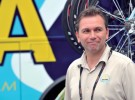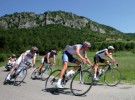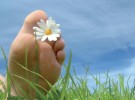We Might As Well Win explains in great detail the strategies used to guide Lance Armstrong to his seven Tour de France victories, including his 1995 yellow jersey, and his years as director of the U.S. Postal and Discovery teams, After what seems a lifetime of seeing Johan on TV, I was prepared for a stern, no nonsense guy with that famous Belgian accent. To be honest, I was more than a little nervous. It’s not every day you speak with one of the most powerful people in cycling. Catching up with him at his home, I found a man comfortable with what he’d achieved so far in life, both as a rider and director sportif. He was relaxed, happy to talk about any subject I cared to bring up and nothing seemed too much trouble for him. Johan seemed very pleased that I’d actually read the book. It must be a nerve wracking thing to put the details of your life into print for the whole world to see. But I think once again, Johan has come out on top.
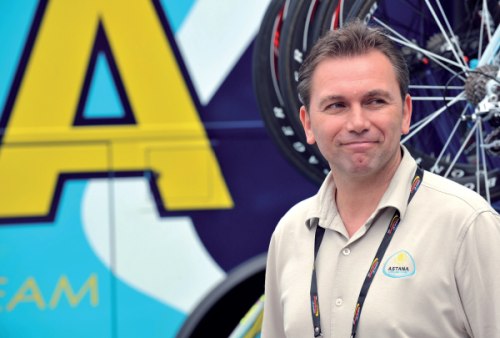
Bicycling Australia: Well, Johan, you’ve written a book called ‘We Might As Well Win’
Johan Bruyneel I have, did you read the book?
BA: Yes, yes I’ve read it twice now actually.
JB: How do you like it?
BA: I like it a lot. In fact when I was trying to write down some questions to ask you for this interview, I couldn’t really think of many that you haven’t already touched on in your book. It’s very open. You don’t leave much for us to guess.
JB: (laughs) Well, of course I didn’t tell people everything. There are still some things I keep to myself.
BA: You’ve obviously read Lance’s two books and I felt that yours wasn’t as good as his first,
but it was better than his second.
JB: Well, Lance is definitely THE story. And it’s such a good story for people who aren’t even into cycling.
There’s no way I could compete with that. But I felt there were still things the public would like to know about.
BA: One thing I found with ‘We Might As Well Win’ and you just touched on that, was a lot of the text seems to be for non cycling fans. Probably the only thing I found a little difficult was that. Things like having to explain what happens when you change gears and suchlike. Was that something which was difficult for you to write?
JB: Oh Yeah, definitely. Because it wasn’t natural for me. Even when I re-read it now, I find parts of it a little simplistic. But you know, it was my aim to reach a broader public than just the cycling world and the response I’ve had, especially from people in the U.S., is that they appreciate that.
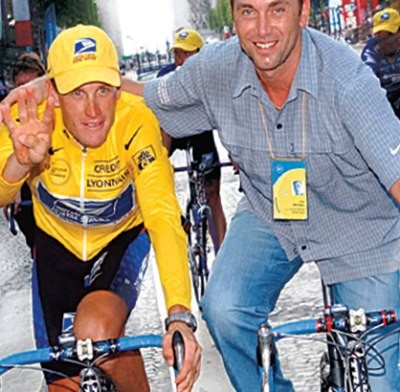
BA: I guess the U.S. is a more difficult market to crack in that way. With that in mind, was it difficult for you, when you moved to America from Europe to be the director of U.S. Postal, to adapt to such a non cycling culture?
JB: I was lucky because I joined an existing team. So they knew a little bit about how it all works. But the fans and the sponsors had a very different outlook than they do in Europe and that was quite a shock for me. I had to make a dramatic shift in my mind to cope with it and focus on different things. But it’s a process that I’ve grown into so it’s OK.
BA: One part that you describe in the book was when you decided that you would aim just for the Tour de France victory. Not follow the traditional route of all the smaller European races, but just have that one big goal. Was it difficult for you to convince the sponsors and directors of this plan, given that you were essentially, the new man, unknown and untried?
JB: This was one case where the lack of cycling culture was an advantage. Because they didn’t actually know a lot about cycling, it was easier for me to convince them that this crazy plan of mine was the way to go. Whereas if I’d been on a European team, it would have been much more difficult. People would have said, “You can’t do this. A team can’t be run in this way. You have to go here and then you have to go there. You must race the smaller races.” Being in America, they didn’t have these pre-conceived ideas. I was able to break that tradition quite easily because the tradition wasn’t there.
BA: And how sure were you that your plan was going to work?
JB: (Laughs) Well, that’s a good question. In hindsight, I don’t think we took that much risk. I mean we had a former World Champion to work with after all. But I was a new director and I said to myself, “If I was a cyclist and my director and my sponsor left me the freedom to prepare for the Tour, what would be the ideal season for me?” And I wrote it all down on a piece of paper and that’s how we did it. They didn’t ask any questions and the sponsor didn’t put any pressure on us. Because for them at that time, the Tour de France was the one and only race which was known in the United States. So it made a bit of sense to them to go for the biggest one. Of course I wasn’t sure in the beginning of the season that we were going to win. But I thought it was worth a try, especially for Lance. Because I didn’t think he had anything to prove to anybody. The fact that he was a bike rider again was enough. I mean 18 months earlier he was almost dead. But I was absolutely convinced by the month of May that he would win. When we were doing our big training rides in the Alps, away from all the other competition, I remember I said to the mechanic, “This is it. If he does this in July, no one is going to beat us.”
BA: Yes, you mention that time in your book.
How difficult was it for you to convince Lance himself that he could win?
JB: Ummmm…it wasn’t that difficult at all. He was very excited about being back at a high level and I kept saying “If you can be fourth in the Tour of Spain without a proper season behind you, then, if we do everything right, you have to be able to win the Tour.” Of course he had some doubts during the season. Who wouldn’t? But in 1999 he felt much better than in 1998. When the classics came, he wanted to race them because those were the races in which he was good at before. It was up to me to remind him of the real goal.
BA: Reading your book, I got the impression that sometimes Lance could be quite a fragile character.
Is that correct?
JB: He’s certainly not fragile, but one of my tasks was when it didn’t go so well, I had to look for more positive news. When you’re a rider in the middle of a race you’re living in a bubble. It was my job to analyse the situation and say hey, it’s not as bad as it looks. The work of a coach is mainly on the psychological side and you can only really get there when you know someone really well. You need to find out what are the sensitive buttons and then know when to push them. And not only know when to push them, but which ones to push.
BA: How difficult was Lance’s marriage breakup to the team and how did you manage to stay out of it.
JB: It was something that he was trying to be very professional about and strong about. But it was something that had us worried.

2003 turned out to be a difficult season for a number of reasons. I’m guessing the marriage problems were part of that. We talked about it. Lance and I have a very close relationship. But in the end, it’s his life and he knew what the situation was. I’m not saying that 2003 was difficult just because of that. It was certainly a factor but I think that the biggest problem in 2003 was the crash in the Dauphine and the fact that he absolutely wanted to continue and win that race. After that everything started to go wrong.
BA: What were your feelings on that last time trial at the Tour that year and you saw that Jan Ullrich had crashed?
JB: We had less than a minute advantage going into that time trial, but we were well prepared going into it. We had driven the course and in the morning I found out that Ullrich hadn’t seen the course at all! So that helped with our morale. It made us feel stronger. That’s not to say we weren’t worried, because Lance had lost to Jan in the first time trial that year. He didn’t need to beat Ullrich, he just needed to be conservative. But we had based our entire plan around Jan and I remember that it was going to be 15 kilometres before we got the first official time check. I didn’t want to wait for that. I put three people out on the course between the start and the first split time. By the time Lance reached the 15km time check, we had four split times already. So we knew immediately, after three of four kilometres, how he was comparing to Ullrich. We saw that he was going even and was in a good rhythm. So we knew that if nothing happened we were going to win. There were a lot of factors that played into our hands before that time trial. Number one, Lance was feeling better as the race went on. Number two, we knew the course and Ullrich didn’t, which was important given the weather conditions. Number three was that there was a tailwind and it is very difficult to gain an advantage in a tailwind. When I saw Ullrich crash I thought, “OK, we’ve got this covered now.” We didn’t care then about winning the stage, I just kept telling Lance to take it easy on all the corners and we would have the yellow jersey in Paris.
BA: Let’s talk about George Hincapie. Do you think he will ever win Paris-Roubaix?
JB: Oh he definitely can, yes. He is built for Paris Roubaix, but for some reason there’s always something goes wrong. Hopefully he will win soon.
BA: While we’re talking about U.S. Postal, Aussie rider Matt White was on your team. Every year here in Australia we all hoped Matt would get a chance to ride the Tour. Why did it take so long?
JB: Well you know, it was very difficult in our team to make the Tour squad. Matt was a super helper but the competition in the team was very hard. Matt always did a great job. He would have been at the Tour every year if he was racing for any other team and sometimes I felt bad, because I knew that he really wanted to do the Tour and I knew he would do a good job. But with Lance, he always wanted the strongest possible team and somehow Matt always missed out.
BA: You yourself wore the yellow jersey in 1995 when you beat Miguel Indurain in a sprint finish into Leige. You then won seven with Lance and another one with Alberto Contador. Out of those, which one is the most special?
JB: Well, I only have one jersey displayed in my house and that’s my one from 1995. I only wore it for one day, but I’m most proud of it. But the first one of Lance’s was pretty special. And Alberto’s was special because it proved to me that I could still win as director without Lance. But my one is the best.
BA: In your book you said that riding over a cliff was for a long time, the thing most people would remember you by. Then years later you visit that same spot with Vladimir Ekimov and he asks you what it was like. You said that in the context of everything else, it was nothing. I understand what you’re saying here, but deep in your heart, it couldn’t really be ‘nothing’ to you to come that close to death could it?
JB: At that moment when it happened, it was unbelievable. I remember that it seemed like I was hanging in the air for a very long time. I had time to think and I remember thinking “This is it, I’m gone.” But the fact that the next thing you think about when you’re still alive is to get back on the bike and go crazy again downhill?
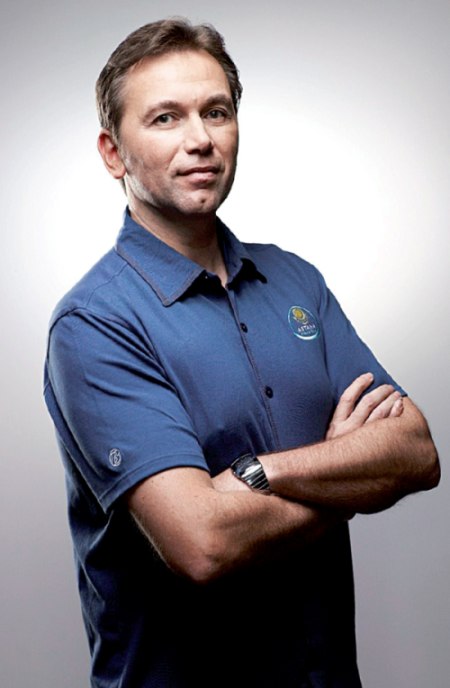
BA: You yourself wore the yellow jersey in 1995 when you beat Miguel Indurain in a sprint finish into Leige. You then won seven with Lance and another one with Alberto Contador. Out of those, which one is the most special?
JB: Well, I only have one jersey displayed in my house and that’s my one from 1995. I only wore it for one day, but I’m most proud of it. But the first one of Lance’s was pretty special. And Alberto’s was special because it proved to me that I could still win as director without Lance. But my one is the best.
BA: In your book you said that riding over a cliff was for a long time, the thing most people would remember you by. Then years later you visit that same spot with Vladimir Ekimov and he asks you what it was like. You said that in the context of everything else, it was nothing. I understand what you’re saying here, but deep in your heart, it couldn’t really be ‘nothing’ to you to come that close to death could it?
JB: At that moment when it happened, it was unbelievable. I remember that it seemed like I was hanging in the air for a very long time. I had time to think and I remember thinking “This is it, I’m gone.” But the fact that the next thing you think about when you’re still alive is to get back on the bike and go crazy again downhill?
Well, that is why I say it was nothing. I had no physical damage at all, just a little thing in my leg. But later, it hit me and I started to realise what had happened. I began to shake and I almost couldn’t get up the mountain. Then, in the evening, when I saw the images. That was the worst. Until I saw it on TV, I didn’t realise how bad it was.
BA: The end of your book comes when you’ve achieved the 2007 Tour win and you say that now you can stop working and spend more time at home with your family. What happened when you told them you’d been offered a place with Astana?
JB: I’m not the director at Astana so that makes a big difference. I’m not as busy. I have busy periods, especially at the beginning when we had to re-build the team, but I still consider myself retired as a sports director. My wife fortunately, was very supportive. She encouraged me in fact to take the position. I like challenges. I’ve proven that I can win races with a team, so with Astana it was like a new challenge for me to get the team back up and running. That team was in big trouble. It needed a complete re-structure, and a more positive attitude.
BA: Getting left out of the Tour couldn’t have helped much could it?
JB: I thought that too when I first was told that we were not in. But now I think it has done us some good. The decision of ASO has helped us improve our image. People see that we are doing the right thing and some of them think we should have been invited. I still think that there are other teams they should have looked at. I mean Rabobank had problems last year. So did High Road and Cofidis and Saunier Duval. Those four teams had positive tests in the Tour last year. So for me, there should have been five teams that were either in or out. Not just one. But anyway, we’ve turned that page and so be it. I think we’ve done a good job so far. If you look at the races we’ve done well in, California, Romandie, Basque country, Switzerland, the Dauphine, the Giro. It couldn’t get a lot better than this.
